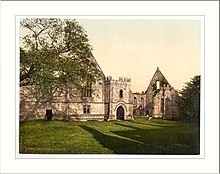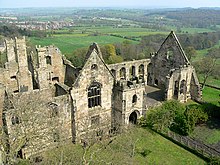Wingfield Manor
Wingfield Manor is the ruins of a manor house about 6.5 km from the small town of Alfreton in the English county of Derbyshire . Today a farm is operated on part of the old manor.
The property, abandoned since 1770, is now managed by English Heritage , but can only be viewed as part of pre-booked tours on one Saturday a month during the summer months. English Heritage has listed the house as a Grade I Historic Building and it is a Scheduled Monument .
history
Wingfield Manor had Ralph Cromwell, 3rd Baron Cromwell , then Chancellor of England, built around 1450 to replace a 12th century castle. Then he sold it to John Talbot, 2nd Earl of Shrewsbury . The construction of this mansion provided the inspiration for the Hampton Court Palace in London .
The Crown entrusted the care of Mary Queen of Scots to the 6th Earl of Shrewsbury after she was arrested in 1569. She lived in several of the nobleman's homes across Derbyshire, including Wingfield Manor. Here she could have met Anthony Babington , whose family lived in '' Dethick '' nearby. Babington organized the Babington Conspiracy , a Catholic conspiracy against Queen Elizabeth I. The walnut tree in the north courtyard is said to have grown from the seeds of the walnut, the sap of which Anthony Babington smeared on his face to make himself unrecognizable and so enter the house to meet Maria. Unfortunately, the tree is not old enough for this story to be true.
During the English Civil War the house was in the hands of John Talbot, 10th Earl of Shrewsbury , a supporter of the Parliamentarians . The mansion was conquered by the royalists in 1643 and recaptured by the parliamentarists the following year after a siege. At that time, the property was in a strategically important position on the country's most important north-south road. At the end of the Civil War, the house was partially razed , but a few years later Immanuel Halton , an astronomer, had it renovated. It was later further damaged when bricks were taken from it to build Wingfield Hall in the valley.
In the remains you can find a still usable tower and parts of a larger tower that housed one of the first water flushing systems in England before the English Civil War. A water tank on top of the tower could be emptied through the toilet into the trench . The remains of the knight's hall , once one of the largest in the country, contains a bay window where the sun once shone through colored glass on the dining table. Wine, beer and food used to be stored in the vaults under the great hall. From there, stairs led up to the knight's hall at all four corners. The kitchens were connected to the knight's hall by a corridor. The remains of two ovens can still be seen today, as well as two large open fireplaces. The damage caused by cannon balls can still be seen along the curtain wall and on the towers. One of them, on the north wall, shows the direction from which the cannons fired during the siege in 1644. There were four 32-pounders borrowed for the occasion. Initially, these cannons were placed on a hill to the east of the house, but the distance was too great and so only a crescent-shaped battery in front of the main gate was damaged, which is now overgrown with plants but is still visible. There is also a large stone barn, the interior wood paneling of which is remarkable. The gate above the entrance to the north courtyard contains stone purses, the mark for the treasurer, Lord Cromwell.
Mary Queen of Scots at Wingfield Manor
In August 1569, the Earl of Shrewsbury wanted to take Mary Stuart away from Wingfield Manor. He wanted to take her to Sheffield because Wingfield Manor needed cleaning. 240 people lived there at that time and the mansion was “unsavory smeared”. In Sheffield the Earl owned two properties, Sheffield Castle and Sheffield Manor, and could easily move the Queen of Scotland from one to the other if cleaning should be necessary. When the Rising of the North began in November 1569, Mary Queen of Scots was still at Wingfield Manor. The Earl of Shrewsbury heard about a conspiracy to free the Queen of Scotland. The Earl of Northumberland and his wife were staying at the nearby Wentworth House at the time . The alleged escape plan was that the Countess of Northumberland pretend to be a nurse and should come to the care of Christine Hogg , the pregnant wife of Sticker Bastian Pagez . The Countess was "something like the queen in person" and was to take Maria Stuart's place while she disappeared.
Queen Elizabeth wrote to the Earl of Shrewsbury on March 14, 1570, giving him permission to bring Mary Queen of Scots back to Wingfield Manor because of the inadequate water supply at Tutbury Castle . The earl had hoped to take Maria to Chatsworth House and had already made arrangements there.
Individual evidence
- ^ Joseph Bain (editor): Calendar State Papers Scotland . Volume 2. 1900. p. 671.
- ^ William Boyd (editor): Calendar State Papers Scotland . Volume 3. 1903, p. 646.
- ^ William Boyd (editor): Calendar State Papers Scotland . Volume 3. 1903. pp. 94, 107.
Web links and sources
- Photographs of Wingfield Manor in Derbyshire, England . DerbyPhotos.co.uk.
- Wingfield Manor . English Heritage.
- Alfred Gotch: The Architecture of Wingfield Manor . Britannia - Historic Derbyshire.
- Wingfield Manor . marie-stuart.co.uk.
- Wingfield Manor (2) . marie-stuart.co.uk.
- Photos of Wingfield Manor and the surrounding area at Geograph.org.uk.
Coordinates: 53 ° 5 ′ 20.8 " N , 1 ° 26 ′ 34.9" W.

